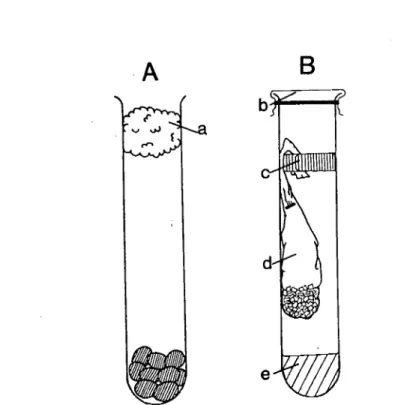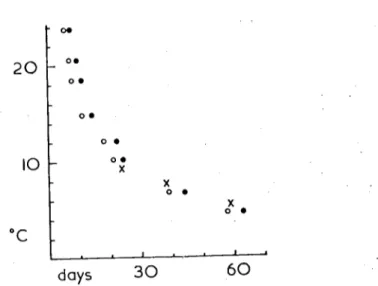THE DUR ATı ON OF PRE-PARASITIC DEVELOPMENT OF TRICHOSTRO:'-l-GYLUS VITRIi'\US AT CONSTANT TEMPERATURES
B.M. Alabay* M.G.Christie*
*
Summary: The pre-parasitic development oj Trichostrongylus vit-rinus was studied at a range oj constant temperaturesjrom 24 to 4.6 oC. There was no evidence either oj a discontinuity at the lower end oj the time and tempe-ratılres curve or oj excessive mortality at the low temperatures. The apparent difjiculty oj relating this jinding to the established epidemiological model is discussed briefly.
Trichostrongylus vitrinus'un 24-4.6°C'ler arasmda değişik ısı derecelerinde pre-parazitik gelişme süresi.
Özet: 24-4.6°C arasında değişen ısılarda Trichostrongylus vitrı-nus'Un pre-parazitik gelişmesi üzerinde çalışıldı. Parazit yumurtalarında geli-şimin oldukça düşük ısılarda da devam ettiği görüldü. Ayrıca düşük ısılarda jazla bir mortalite gözlenmedi. Bu bulguların epidemiyolojik modelle olan
ilişkisi kısaca tartışıldı.
Introduetion
.The changes in the composition of the trichostrongylid worm
burden of lambs at pasture during the course of the grazing season
have been studied in Great Britain by Heath and Michel(g),
Corn-well(2) and Boag and Thomas(ı). These observers alı found that
substantial b,urdens of intesrinal Trichostrongylus only appearecl later in the y~ar than those of Ostertagia. In 2 of the g years of
obscr-vations made by Cornwell (2) and in those made by Boag and
Tho-• Dr.med.vet. Ankara University, Faculty of Veterinary Medicine, Department of Parasitology, Ankara .
•• BA. Animal Diseases Research Association, 408 GiImerton Road, Edinburgh EHI77lH.
THE DURATION OF PRE-PARASITIC DEVELOPMENT... 145
mas(ı) T.uitrinus was the predominant species. Boag and Thomas(ı), suggested that the succession of species could be explained in terms of the lenght of free living development of the individual species. This paper records measurements of the time required for completion of development by T.uitrinus from egg to infeetive larvae (1.3) at
cons-tant temperatures in the laboratory.
Materials and Methods
Faeces were collected from the rectum of a sheep with a mono-specific infection of T.uitrinus and wcre set up in their experimental
environment within one hour of collection.
Developing material maintained by method A (see bclow) was
incııbated in smaIl insulated water baths housed in a eold room. These baths ran at 4.6,6.7, 10.2, 12.1, 14.8, 18'5 and 2o.6°C and the
extre-mes of variation were =ı= 0.2 oC. Materials were also ineubated at
24 =ı= ioC in a elimate room. The material maintained by method
B was incubated at 5.3 and 7.6°C in commereial cooled incubators
with a fluctuation of =ı= ioC and in a laboratory OVenat 9.3°C sited in th.e eold room: extremes of variation in the oven were =ı= o.ioC.
Two methods, A and B, were used and are illustrated in Fig. i.
Method A: 8-io g of faeeal pellets were placed directly in each i50X
25 mm test tube and the tube was plugged with- eotton wooI. The plug wa,s moistened daily a few drops of water. Six tubes were set
up at each tempcraturc. For examination an emulsion of 3 pellets
was prepared in tap water, filtered through asieve of o. 7 mm aperturc and eentrifuged briefly, the sediment was washed 3 times andthen transferred to a petri dish and searched at a magnification of X 20. The first 30 larvae seen wer<: collected with a capillary p~pctte_and
tested with NaOCL. Method B: when the faeces werccollected from
the sheep a 10% emulsion was prepared in İ?-P water and mixed with absorbent mineral granules (cat litter) tL?give a. cmmbly ffiixture.
An aliquot of the mixturc containing approximately 0.7 g of the
original faecal material was wrapped in hemp paper and suspended in a tubc as shown in Fig. i.The tube was elosed with polythene film. For examination, io ml of water was added to. the tube and the"
pac-ket was pushed down into the water. After 2 hrat.room .temperature
to allow migration of the larvae, the paekctwas discarded, the.
lar-wae were counted and tested with NaOCL. ~
A
B
Fig. i. Two methods (A and B) of maintaining devC:loping eggs and larvae. Cotton wool
plug (a), polythene film (lı), plastic split ring (c), hemp paper sack (d), 2ml tap water (e).
Larvae were held in 0.2
%
NaOCl for 30 minutes and thenkil-led by addition helminthological iodine to a finished concentration
of approximately 0.2
%
iodine. The stained larvae wereexami-ned at X 100 and c1assificd as L3 (those which had esheathed) or
not L3•
Samples offaeces were examined at intervals of2 or 3 days
star-ting at times suggestedly knowledge of the time and temperature curve for Ostertagia circıımcincta. The times recorded here are those by which
> 50% and> 85% (Method A) or > 85% (Method B) of larvae
were classified as L3 by the NaOCl test. Results
The results are shown in Fig. 2. Development in whole pellcts,
as studied by. method A, was successfully completed to L3 at all
tem-peratures investigated. More than 85% of the larvae recovered had
THE DURATION OF PRE-PARASITIC DEVELOPMENT... 147 oe 20 o. o. o. o • LO o.x x o • X o • oC days 30 60
Fig. 2. Time required by T. vitrinus for development to L3 at constant temperatures shown: method A 50% (o), 85% (.); method B 85% (x).
days at 4.6°C. The ability to complete development at temperatures aslow 5.3°was confirmed by method B. The mean yie1ds of L3 caleu.
lated as percentages of the estimated numbers of eggs set up for study by method B at 5'3,7.6 and 9.3°C were 74"94 and 81%, respective1y.
Discussion
Two' methods of recovering larvae for examination were used. The laborious method A, in which recovery does not depend on the motility of the larvae, wasused in anticipation of the possibiHty that
while. eggs would hatch at the lower temperatures, the eİnerging
larvae might die as Lı or Lı. In [act method A established the ability ofsome larvae to complete development to L3 at aLLthe temperatures
tested and the existence of a regular re1ationship between
tempe-rature and development time, but the method did notgive an esti~
mate of the propotion of eggs which reached L3• Method Bshowed
that a high propotion of eggs completed development at temperatures down to 5.3 oC.
Th~ limited amount of published data indicates that other spe-cies of the genus Trichostrongylus do not develop at such low tempe-ratures as T. vitrinus.Levine and Anderson (4), found that T.
colubri-iformis would not usually develop to L3 when soil surfaee temperatures
were below ıo°C. Mirzayans(s), demonstrated that at S OC. the eggs
of T.axei fail to develop to the infeetive stage.
it is not immediately obvious how our laboratory information
on the rate of development to L3 can be related to the observed
epi-demiology of T.vitrintıs. Boag and Thomas(ı), who reported a
sud-den rise of T.vitrinus burdens to quite subst?ntial numbers in
Sep-tember, concluded that there was onlyone gencration of T. vitrinus
during their trial a.nd that this species was transmitted by the ewe egg
output. Using the development times taken from our Fig. 2 and
as-suming me an monthly temperatures of gOC. in May, 12°C. in June
and 14oC. in July, the period from the time of the post parturient rise in ewc egg output to the end of julyappears to offer four times the number of dcgree days necessary for the completion of develop-ment of T.vitrinus to the infective stage. While it is possible to devise
a number of hypothetieal explanations for the 'lost time'
ofmore-than 60 days in terms of the time taken for larvae to return from the soil or mat to a location in which they can be ingested by lambs, or in terms of changes in the chances of ingestion resulting fromchan-ges of eating habit as the pasture gets eatden down at the end of the summer, it is diffieult to see why the epidemiology of Ostertagia wo-uld not be infIuenced in the same way.
ReCerences
1- Boag, B. and Thomas, R.J. (1977): Epidemiological studüs on gastrointestinal nematode
parasites of shap: t1ı4seasonal number of gennations and SlIecusion of speci~s.Res.vet. Sei., 22:
62-{j7.
2- CornweD, R.L. (1975): The Pattern of injection with gastrointestinal nematodes in young
fauming lamos at posture. Res. vet.Sd., 18: 1-5:
3- Heatb, G.B.S. and Michel, J.F. (1969): A contribution to the epidemiology of parasitic
gastroenteritis in lambs. Vet.Rec., 85 :305-308.
4- Levine. N.D. and Anderson, F.L. (1973): Development and surUÜJalof Trichostrongylus
cOluhriforr,!is on pasture. ].Parasİt., 59': 147-165'
5- ~zayans, A. (1969): The yject of temperature on the development of t1ı4 eggs and larvae of
Trichostrongylus axei. Br.vet.]., 125: XXXVII. .

